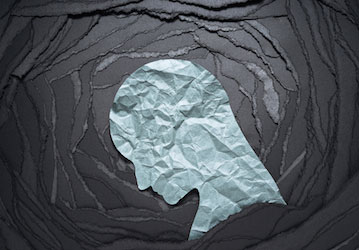Imagine your battle buddy is upset, calls you, and says, “I’m going to die alone” because they failed to report one time. You might think they’re being ridiculous and want to tell them to snap out of it, but what’s really happening is they’re catastrophizing—or magnifying a situation and getting stuck in irrational worst-case fears. And even though their fears might be unreasonable, in that moment they seem real. The upshot is that there are ways to notice, understand, and manage things when you or someone you care about is catastrophizing.
Downward spiral
The jump from “failing to report one time” to “I’m going to die alone” might seem extreme and unlikely. However, when you catastrophize, your brain is making small, sometimes logical, “if...then” connections that slowly build up to an irrational worst-case outcome. Look at the example below to learn how this works.
- “I failed to report, and it could result in me getting an article 15.”
- “If I get an article 15, then it’s going to cause major problems with my career.”
- “If my career becomes a mess, then my spouse will get mad, causing even more pressure to build up.”
- “If I can’t handle all that pressure, then I’ll eventually get chaptered out of the military.”
- “If I lose my job, then my spouse will get fed up and finally leave me.”
- “If my spouse leaves, then they’ll likely get custody of the kids, and I’ll lose touch with them.”
- “If I lose a connection with my kids, I’ll completely fall apart and die alone.”
The jumps between thoughts often seem sensible and lead to a logical, final outcome—even though it might be extreme from what will actually happen.
Break out of catastrophic thinking
Here are 3 strategies that can help if you or others are struggling with catastrophic thinking.
- Write it down. Getting thoughts out of your head and onto paper helps you take a clearer view of things. When you see on paper that you or your battle buddy think, “I’ll never get a job” because you failed one test, it helps you to push back and ask, “Is this really the case?”
- Take a positive mental break. When you think the world is falling apart, a positive mental break can help clear your mind. For instance, have you ever been really anxious because you were running late and couldn’t find your keys—but after you calmed down you noticed they were on your bed right in front of you the whole time? When you’re overwhelmed with negative emotions, it’s hard to think rationally. So, try to do something that will distract you for a minute or two to help you laugh or feel some other type of positive emotion. Positive feelings help ease the effects of stress, anger, and other negative emotions. Try watching a funny video, go for a run, or maybe list as many funny or unrealistic best-case outcomes that can come from this. Positive mental breaks can help you calm down and put you in position to refocus on the issue at hand.
- Focus on your breathing. When your emotions aren’t helpful, you can change their intensity with controlled breathing. Calm yourself by slowing down your breathing and taking long belly breaths. Deep breathing also helps you practice mindfulness, return from worst-case future fears, and hone in on the present moment.
Bottom line
You’re more likely to catastrophize when you’re tired, stressed, and drained. So break out of it by writing things down, clearing your mind, and focusing on your breathing. In addition, make sure to get quality sleep, eat right, and exercise regularly to have the energy and mental resources to handle challenges with a clear mind.
